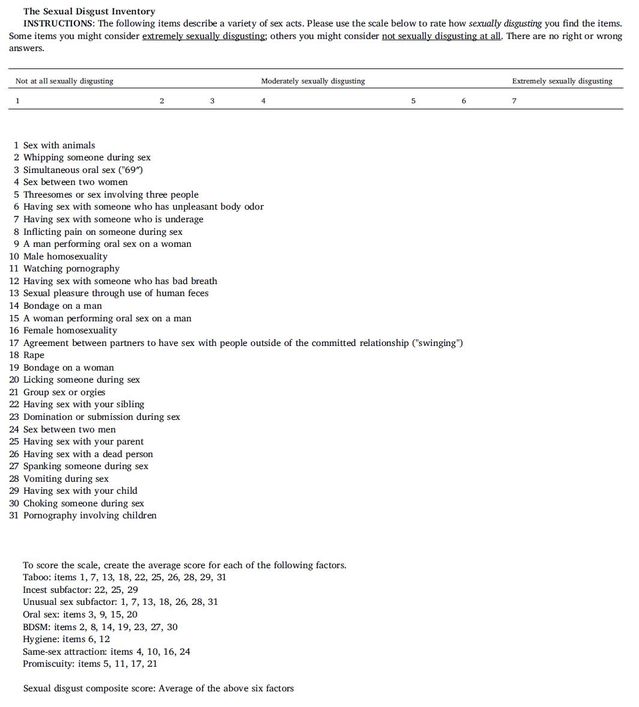Sex
The 6 Major Types of Sexual Disgust
... and who is more likely to experience it.
Posted January 5, 2020 Reviewed by Hara Estroff Marano

Sexuality appears to be undergoing a sea change on a collective level—but is this true?
For many, divergence from conventional sexuality is still seen as deviant and dangerous. While sexual attitudes are shifting toward greater acceptance of formerly off-limits behaviors, including open relationships, short-term sexual encounters, and greater variety in acceptable sexual behavior—including same-sex activity and heightened sexual adventurousness—for others, anything but vanilla remains repugnant.
What is healthy sexuality? There are grey areas, and while some behaviors are overtly considered universally problematic, they may still be tolerated, or worse.
An Evolutionary Basis for Disgust
Disgust, in general, is a core experience, keeping us away from all kinds of nastiness. For example, food that tastes bad often makes us sick, so disgust keeps us from eating poisonous food. At the same time, too much disgust means no one ever eats anything new, which could be deadly in times of scarcity.
Sexual disgust may serve important survival functions—protecting against disease transmission, keeping us from making problematic mate choices, and stopping us from doing things that could cause social damage or ruin, depending on your social group.
Too much disgust is paralyzing, interfering with function in many ways and keeping us from necessary risks. Because sexuality is linked to political and cultural values, sexual disgust may also vary as a culture is more or less repressive, feeding back onto attitudes about mating and marriage.
Evolutionary theory suggests that disgust is a highly conserved emotion because it helps with survival and reproduction on individual and collective levels. Individual variation creates collective diversity, so having a range of possibilities allows greater adaptability in a changing environment. We need a range of attitudes about sexuality for overall group survival, but the group also has to be able to work with whatever internal strife arises.
Defining Sexual Disgust
In spite of the importance of sexual disgust, it hasn’t been spelled out in detail. In order to remedy this, authors of a recent study (Crosby, Durkee, Meston and Buss, 2019) conducted three studies to quantify and measure sexual disgust. They also started to look at how sexual disgust varies with other factors, like gender, politics, and religion.
The first study had 225 participants with an average age of 35 years. They came up with 2,300 behaviors contributing to sexual disgust, which distilled into 50 behaviors that were clustered into 6 major factors. Please consider before reading, as many of the specific behaviors described may be triggering:
1. Taboo
- Having sex with your child
- Having sex with a dead person
- Sex with animals
- Rape
- Pornography involving children
- Having sex with your sibling
- Sexual pleasure through the use of human feces
- Vomiting during sex
- Having sex with your parent
- Having sex with someone who is underage
2. BDSM
- Whipping someone during sex
- Inflicting pain on someone during sex
- Bondage on a woman
- Choking someone during sex
- Domination or submission during sex
- Bondage on a man
- Spanking someone during sex
3. Oral Sex
- A man performing oral sex on a woman
- Simultaneous oral sex (“69”)
- A woman performing oral sex on a man
- Licking someone during sex
4. Same-Sex Attraction
- Male homosexuality
- Sex between two men
- Female homosexuality
- Sex between two women
5. Promiscuity
- Group sex, or orgies
- Agreement between partners to have sex with people outside of the committed relationship (“swinging”)
- Threesomes, or sex involving three people
- Watching pornography
6. Hygiene
- Having sex with someone who has unpleasant body odor
- Having sex with someone who has bad breath
Sexual Disgust and Individual Traits
The second study validated the Sexual Disgust Inventory and started looking at political and religious orientation, gender, and personality as measured by the Brief HEXACO Inventory. HEXACO looks at personality on six dimensions: Honesty-Humility, Emotionality, Extraversion, Agreeableness, Conscientiousness, and Openness to Experience, overlapping with the Big Five model but including Honesty-Humility as a separate element and with Emotionality paralleling Neuroticism.
The same approach was used in the third and final study to look at these factors in a second group. There was a lot of overlap but some differences between studies two and three when it came to which sexual disgust factors went along with which individual traits. Both groups contained a balanced mix of men and women, 70 percent white and 90 percent heterosexual, with an average age of about 35 years.
In this mainly heterosexual group, women expressed greater disgust than men, associated most strongly with Promiscuity in the third study. An evolutionary explanation for this is that a male with more mates will have more offspring, but women risk losing out on having a long-term partner for childrearing and expose themselves to greater disease risk. From an evolutionary point of view, this would incline women toward long-term mating.
Short-term mating was associated with sexual disgust, heaviest for the Taboo factor. Although one might expect short-term mating to correlate most strongly with Promiscuity, the evolutionary risk may be higher if short-term mating increases the likelihood of dangerous taboo violation.
Religious and political beliefs were correlated with sexual disgust, particularly Same-Sex Attraction. More conservative participants had stronger aversions to homosexuality and sexual activity with members of the same sex. Openness was associated with less disgust, correlated with oral sex and same-sex attraction in the second study.
The Future of Sexual Disgust
The Sexual Disgust Inventory, the main product of this study, sets a new standard. Future research using this tool to conduct larger studies with different groups will deepen understanding. It’s also important to exercise caution and recognize that research, and research findings in general, can be used politically and culturally. The intent here is to understand sexual disgust and begin to look at correlations—not to further moral or political agendas.
Nevertheless, because sexual disgust is such a powerful evolutionary agent, understanding it is critical for making sense of contemporary culture, given all the changes occurring around mating, gender, and sexuality across all cultural and political groups.
As with other tools, such as those to measure disagreement in relationships, the Sexual Disgust Inventory is useful for understanding individual and couple experiences. While it is not intended as a clinical tool, the SDI can inform inquiry by naming behaviors and providing a framework for understanding them, reducing stigma, and providing a context for constructive dialogue around topics often harmfully shrouded in secrecy. Disgust and shame are close cousins.
The Sexual Disgust Inventory

An ExperiMentations Blog Post ("Our Blog Post") is not intended to be a substitute for professional advice. We will not be liable for any loss or damage caused by your reliance on information obtained through Our Blog Post. Please seek the advice of professionals, as appropriate, regarding the evaluation of any specific information, opinion, advice, or other content. We are not responsible and will not be held liable for third party comments on Our Blog Post. Any user comment on Our Blog Post that in our sole discretion restricts or inhibits any other user from using or enjoying Our Blog Post is prohibited and may be reported to Sussex Publishers/Psychology Today. Grant H. Brenner. All rights reserved.
Facebook image: fizkes/Shutterstock




